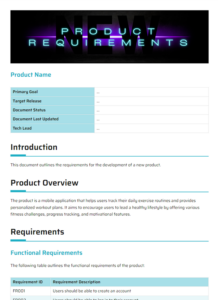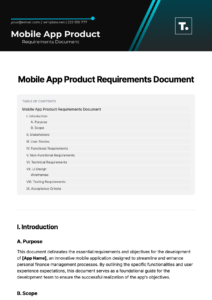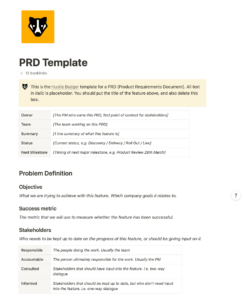Crafting a comprehensive mobile app product requirements document (PRD) is crucial for the success of any software development project. A well-structured PRD sets the foundation for effective communication, ensures clarity of purpose, and guides the development team throughout the app’s lifecycle.
Creating a PRD from scratch can be a daunting task. Fortunately, utilizing a template can streamline the process and ensure that all essential elements are covered. A mobile app product requirements document template provides a structured framework that guides you through the documentation process, ensuring that key aspects such as scope, features, and user stories are thoroughly defined.
Defining the Scope and Objectives
The first step in creating a mobile app PRD is to clearly define the scope and objectives of the app. The scope should outline the overall purpose and functionality of the app, while the objectives should articulate the specific goals and outcomes that the app aims to achieve. By clearly defining the scope and objectives, the PRD establishes a shared understanding among stakeholders and ensures that the app is developed with a clear sense of direction.
To effectively define the scope, consider the following questions: What is the primary purpose of the app? What specific user needs does it address? What are the key features and functionalities that the app will provide? Equally important is defining the objectives. Consider questions such as: What business goals are the app intended to meet? How will the app measure success? By addressing these questions, the PRD establishes a solid foundation for the app’s development.
In addition to defining the scope and objectives, the PRD should also include a description of the target audience. Identifying the users who will be using the app, their demographics, and their needs ensures that the app is tailored to their specific requirements. A well-defined target audience also allows for more accurate user testing and feedback.
Documenting Features and Functionalities
The heart of the mobile app product requirements document template lies in the documentation of features and functionalities. This section should provide a detailed description of each feature, its purpose, and how it contributes to the overall user experience. For each feature, include use cases, user stories, and acceptance criteria to ensure that the development team has a clear understanding of the desired functionality.
When documenting features, consider the following aspects: The functionality of the feature, including its inputs, outputs, and any underlying processes. The user interface (UI) and user experience (UX) design elements, ensuring that the feature is intuitive and easy to use. The performance requirements, such as response time and resource utilization. The security and privacy considerations associated with the feature.
By thoroughly documenting the features and functionalities, the PRD serves as a blueprint for the development team, ensuring that they have a comprehensive understanding of the app’s intended behavior and functionality.
Conclusion
A mobile app product requirements document template is an essential tool for any organization embarking on the development of a mobile application. By providing a structured framework for documenting the scope, objectives, target audience, and features, the PRD ensures that all stakeholders are aligned on the vision for the app and that the development team has a clear path to follow.
To maximize the effectiveness of the PRD, it is crucial to involve all relevant stakeholders in the documentation process. This includes product managers, developers, designers, and end-users. By gathering input from diverse perspectives, the PRD can be refined and tailored to meet the specific needs of the project. Regular review and updates of the PRD throughout the development lifecycle are essential to ensure that it remains актуальным and responsive to changing requirements.


